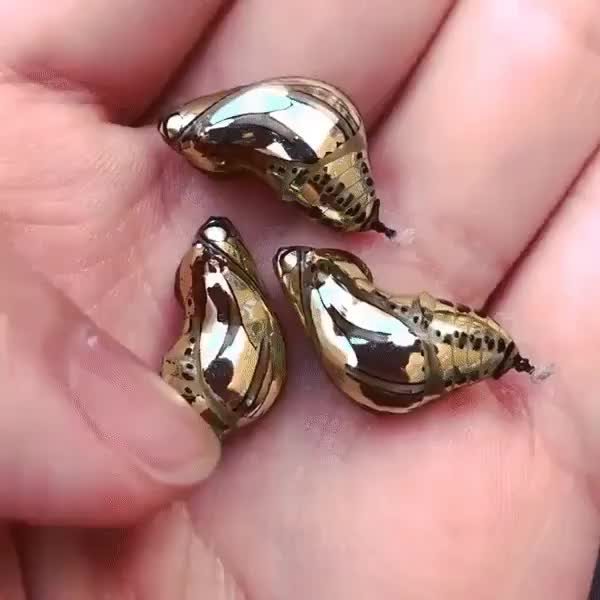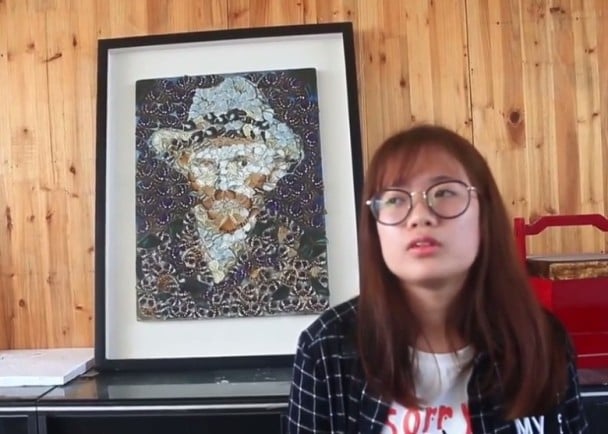This Dead Leaf Is a Perfectly Camouflaged Butterfly

Kallima inachus, a species of nymphalid butterfly found in India and Japan, is known as the orange oakleaf or dead leaf butterfly for a very good reason – with its wings closed, this butterfly closely resembles a dried tree leaf. It’s been said that the kallima inachus butterfly mimics a dead leaf better than an […]
Living Jewelry – The Shiny Cocoons of This Exotic Butterfly Look Like Gold Jewels

Butterfly pupae are easy targets for predators in search of an easy protein-rich meal, and one would think that the flashier the cocoon, the higher the chances of being spotted and eaten , but the Mechanitis polymnia, aka the orange-spotted tiger clearwing and its shiny, gold-like pods are proof that the opposite is true. The orange-spotted […]
Artist Faces Backlash After Killing Butterflies And Using Their Wings for a Painting Symbolizing Rebirth

A Chinese art student sparked a heated debate online after using the wings of over 500 butterflies to create a series of artworks symbolizing rebirth. While some consider her “sick” for using butterfly wings as an art medium, others think her creations qualify as original art. Li Zheng, a fourth-year art student at Quanzhou Normal University […]
Mexico’s Butterfly Forest – A Unique Natural Wonder under Threat
Every year, hundreds of millions of Monarch Butterflies from Canada and the United States journey as far as 2,500 miles to the forests of Michoacan, Mexico in what is known as the world’s largest insect migration. Countless butterflies cluster together both on the trees and on the ground, covering large areas into carpets of orange and black. It’s […]
Artist Turns Old Circuit Boards and Electronic Components into Beautiful Winged Insects
UK-based artist Julie Alice Chappell has chosen an unusual medium for her sculptures – discarded electronics. She tears out circuit boards and other components from broken devices, and converts them into delicate insect figurines. Julie’s introduction to the unique art form occurred several years ago, when she happened to find a big box of tiny electronic components at ‘The […]
Mexican Artist Recreates Classic Paintings on Real Butterflies
After experimenting with candy and toothpaste paintings, Mexican artist Cristiam Ramos is now working with preserved butterflies. He spends several hours pouring over each wing, painstakingly decorating them with detailed replicas of classical paintings. Butterfly wings don’t naturally make for good canvases – they’re small, and the texture isn’t altogether right for painting. They’re each […]
Nature’s Wonders – Amazonian Butterflies Drinking Turtle Tears

Deep in the western Amazon rainforest, live butterflies that drink turtle tears. That sounds like a line straight out of a fantasy novel, but it’s one hundred percent real life! It’s an unusual sight – swarms of butterflies flocking at the eyes of yellow-spotted river turtles, trying to get a sip. The poor turtles keep […]
Russian Artist’s Paintings Are Made with Dead Butterfly Wings

Vadim Zaritsky, a former police officer turned artist and entomologist uses a very strange medium for his artworks – butterfly wings. The subjects of his unique paintings range from landscapes and still life to portraits of political figures and famous artists. I know it sounds cruel, but before you label Vadim Zaritsky’s art as a […]
